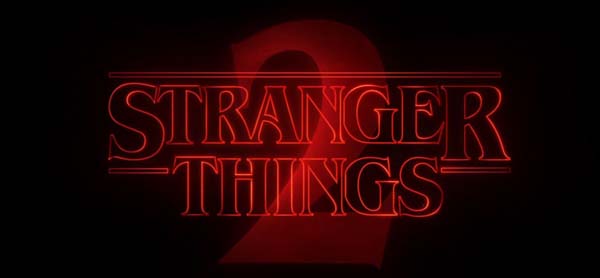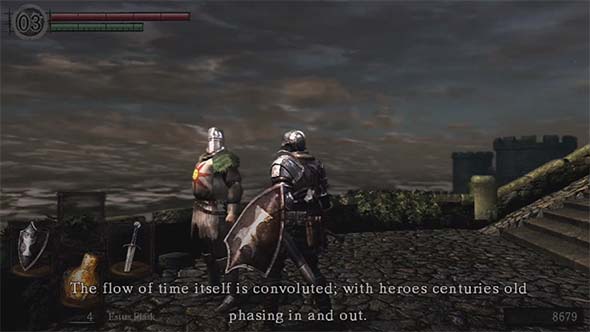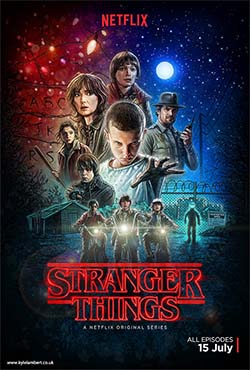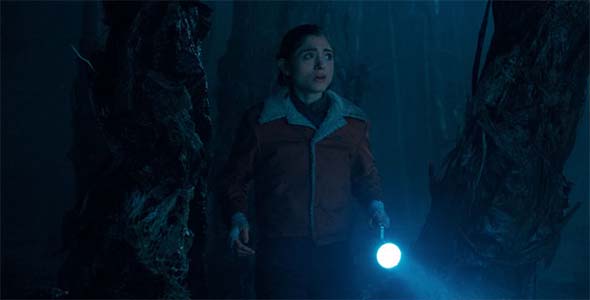
The first season of Stranger Things was a mysterious and intriguing piece of television that successfully channeled an eclectic collection of 80's and 90's nostalgia (from E.T. to Stephen King to The X-Files to Dungeons and Dragons). Instead of being a cynical piece of derivative nostalgia bait (or an outright cash-in on established intellectual property), Stranger Things somehow felt wholly fresh and original.
Unfortunately, season 2 lacks a lot of that mystery and originality that made it's predecessor work so well. Season 2 just feels too familiar. We already know about the Upside Down, and the Demogorgon, and Eleven's psychic powers, and the secret government research lab conducting shady experiments. None of that can really carry the show anymore. But that's about all that season 2 has. There's nothing very new. There's no surprises.
The introduction of a new girl creates tension within the group.
Compounding this problem is that plot points and set pieces feel recycled from last season. Most are inverted in some way, as if they are Upside Down reflections of the previous season's events. But that isn't nearly as clever as the wordplay might make it sound. For example, there's a sub plot of tension among the boys because a new girl has entered their group. This time, it's Max instead of Eleven, and it's Mike who's unhappy with the new dynamic of the group instead of Dustin and Lucas. Midway through the season, there's a set piece in which Will draws a bunch of pictures and hangs them up all over the house. It feels like a repeat of Joyce hanging up the Christmas lights, except that it's Will trying to communicate with the Upside Down instead of Joyce trying to communicate with her son. And the group even takes in another stray and tries to hide it; except this time, it's a baby demogorgon instead of Eleven.
There's a sort-of new monster in the form of the "Shadow Monster" that haunts Will. This shadow monster, however, doesn't really do anything, and we're left with only the army of dog-like demogorgons. It takes an approach similar to James Cameron's Aliens , in that it multiplies the number of monsters, gives them a "nest", and adds some big "queen" that seems to be controlling everything. This comparison is driven home by the shadow monster's resemblance to a ghostly xenomorph, and the inclusion of a scene that was basically pulled straight from Aliens (right down to the beeping motion detectors). But unlike Aliens , I never felt threatened by the surplus of demogorgons, and the Upside Down never seemed as mysterious as the xenomorph hive or their horrifying queen.
The "Shadow Monster" is a threat that never really pays off -- at least not this season.
While the first season didn't revel in sudden character deaths for the sake of shock value like Game of Thrones , the sudden death of Barb midway through the season did manage to raise the stakes for everyone else. Season 2 has nothing like that. There's no sudden or unexpected deaths of any characters who aren't obviously disposable from the moment they arrive on scene. And even among the cannon fodder characters, the death count is still ridiculously low... [More]
0f5034ae-53fd-4a38-8c01-c631eb8cbe1a|0|.0
Tags:Stranger Things, Netflix, streaming television, horror, thriller, science fiction, monster, parallel dimension, upside down, Twin Peaks, Stephen King, Silent Hill, Otherworld, E.T., Stephen Spielberg, the X-Files, Dungeons & Dragons, Ghostbusters, Aliens, 1980s, 1990s, nostalgia, Gaten Matarazzo, David Harbour, Sean Astin

Perhaps I just have a bias against parallel dimensions (as evidenced from my interpretation of Silent Hill's otherworld), but I want to take some time to clear up what might be a mis-conception in the conventional wisdom interpretation behind Dark Souls' multiplayer summoning mechanics. Dark Souls co-op is not necessarily based on parallel dimensions, as many players seem to assume. It might, in fact, be intended to be an abstraction of some kind of time travel. I've noticed that many players online already seem to refer to the multiplayer mechanic of these games in terms of time travel, but I've yet to see any wikis, lore videos, or blogs that seem to explain multiplayer as a time travel mechanic.
I want to preface this analysis by stating that I'm not asserting that the following explanation is the absolute, 100% correct interpretation of the mechanic. Individual players may disagree based on their own reading of the game, and I'm personally somewhat conflicted on the topic myself. I merely want to propose this as a possible alternative to the defacto "parallel worlds" interpretation. I'm going to point out in-game evidence that supports the idea that Dark Souls' multiplayer is based on time travel, but there is also in-game evidence and mechanical evidence that flat-out contradicts that interpretation. I will address those contradictions as well. So that being said, please keep an open mind, and enjoy the read!
The summoning mechanic
There are two games in the series that are not part of the Dark Souls franchise, and which have different in-game explanations and rules for the same multiplayer features (more or less). Those games are, of course, Demon's Souls and Bloodborne. Both have asynchronous multiplayer and summoning mechanics that work similarly to Dark Souls.
Demon's Souls summoning operates under the idea of summoning the spirit of a fellow adventurer who's soul is trapped in the Nexus. This is why you must be in soul form in order to be summoned. Bloodborne's beckoning operates [similarly] under the principle of manifesting hunters out of dreams (which seems to operate under a similar cyclical paradigm to Dark Souls, but I'm not 100% sure). In Dark Souls, you aren't necessarily summoning ghosts (as you do in Demon's Souls), since the undead in Dark Souls are more akin to zombies than ghosts. Also, characters in Dark Souls can leave summon signs whether they are hollowed (dead) or in human form (revived), which is a significant alteration from Demon's Souls. A lore reason for summoning is provided in Dark Souls:

Solaire explains to us how summoning works:
"We are amidst strange beings, in a strange land.
The flow of time itself is convoluted; with heroes centuries old phasing in and out.
The very fabric wavers, and relations shift and obscure.
There's no telling how much longer your world and mine will remain in contact.
But, use this, to summon one another as spirits, cross the gaps between worlds, and engage in jolly co-operation!"
Both Solaire's dialogue, and the White Sign Soapstone (along with other online play items) make references to other "worlds", which leads to many jumping to the conclusion that each player's game is a sort of parallel universe within the Dark Souls lore. However, this may not necessarily be correct. Both Solaire's dialogue and the soapstone also provide explanations for these worlds: "time is convoluted | distorted". This seems to be the explanation for what is meant by "worlds", and it seems that Solaire and the in-game descriptions may be using "time" and "world" interchangeably (could it be a translation / localization issue?). The phrasing in the white soapstone's description joins "the flow of time is distorted", and "the White Soapstone allows undead to assist one another", into a single, compound sentence, which definitely implies that the two phrases (and ideas) are linked.

"Online play item. Leave summon sign.
Be summoned to another world as a phantom through your sign, and defeat the area boss to acquire humanity.
In Lordran, the flow of time is distorted, and the White Sign Soapstone allows Undead to assist one another"
The dialogue of Saulden (the Crestfallen Warrior of Dark Souls II) is even more explicit... [More]
b4b5ccdc-fe67-4add-901b-a41077204778|4|5.0
Tags:Dark Souls, Dark Souls II, Dark Souls III, lore, summon, phantom, multiplayer, From Software, time travel, paradox, grandfather paradox, predestination paradox, parallel dimension, soapstone, Solaire, Crestfallen
Warrior, Crestfallen Saulden, Lautrec, Ringfinger Leonard, Anri of Astora, Sirris of the Sunless Realms, Black Iron Tarkus, Iron Golem, Anor Londo, invasion, Demon's Souls, Bloodborne

After P.T. took the PlayStation Network by storm two years ago (geez, has it already been that long?), I set up my Google news feed with a subcategory specifically for Silent Hill news. I wanted to keep up with the progress of the game, since it looked like the most promising project the series had seen in a decade. After the traumatic cancellation of Silent Hills, that news feed has been mostly populated with articles mourning the loss, or with conspiracy theories about the game's return. Lately, however, a new story has been repeatedly populating that news feed: reviews and interpretations of the Netflix original series "Stranger Things".
With the internet's insistence that Stranger Things is "the show that Silent Hill fans have been waiting for", and some recommendations from co-workers and friends, I decided to give Netflix's new horror thriller a chance. So while House of Cards and Daredevil still sit unwatched in my Netflix queue, my girlfriend and I powered through all eight episodes of Stranger Things within a week.
Stranger Things reminded me a lot less of Silent Hill, and a lot more of Twin Peaks and E.T., but I loved the series nonetheless. I found myself amazed by just how much the show looks and feels like something from the late eighties or early nineties, and by how well it manages to capture a sense of nostalgia for its sources of inspiration without having to license them outright. Hollywood could learn a thing or two from this show. The insistence on reviving franchises like Star Trek, Star Wars, Ghostbusters, Transformers, Ninja Turtles, Power Rangers, The X-Files, etc., is starting to wear very thin. At best, these films feel like high-budget fan fiction. At worst, they feel like cynical attempts to play off of nostalgia for a quick cash-grab. Very rarely do they feel like genuinely inspired works of creative art. This reliance on adaptation instead of inspiration has created a dearth of creativity that in many cases has tarnished once-venerable intellectual properties.

The internet claims that Stranger Things is "the Silent Hill show that fans have been waiting for".
Stranger Things doesn't stoop so low. It wears its influences proudly on its sleeves, but it also remains, thankfully, it's own entity. It never feels derivative; it never feels stale; and it never feels creatively bankrupt. It's not exactly original (as it blatantly incorporates elements of its inspirations into its plots and characters), but it also manages to occasionally surprise with its clever subversions of genre tropes. It never feels like the shallow fan service that I've gotten so used to seeing from Hollywood blockbusters, and (most importantly) I could enjoy it without the baggage of expectations from a recognized namesake.
Much of this is due to the characters and performances, all of which are great... [More]
29ff0687-543f-4935-8af9-e9510696220b|1|5.0
Tags:Stranger Things, Netflix, horror, thriller, science fiction, monster, parallel dimension, upside down, Twin Peaks, Stephen King, Silent Hill, Otherworld, E.T., Stephen Spielberg, the X-Files, Dungeons & Dragons, 1980s, 1990s, nostalgia

The depiction of the town of Silent Hill in its titular game has lead to a lot of confusion and over-analysis from many casual and some hard-core Silent Hill fans. The stories of the first few games are told in very indirect manners, with the player often being shown the story through the acquisition of clues and context, rather than being directly told what is going on by an objective character or outside narration.
One of the most common misconceptions about the games is the idea that the “Otherworld” in Silent Hill is some kind of “parallel dimension” that exists in conjunction with, but separate from, the “real world”. Alternatively, some fans claim that the games utilize some kind of “parallel perception” mechanism, in which everything that happens in the games that is even remotely supernatural is all just happening inside the character’s mind, such that separate characters can be in the same place at the same time, but see things differently. These interpretations have lead to many misunderstandings about other elements of the town and events, such as Alessa having hostile motivations, the residents of Silent Hill being turned into monsters, or that the people who visit the town can never truly leave.
These ideas are all fallacious, and they are derived from fundamental misunderstanding due to how the game presents information, or by a reliance on out-of-game information that presents a false picture of what is happening in the games.
What’s worse, these misguided ideas have found their way into “official” Silent Hill material, including the motion picture and all of the post-Konami-developed games in the series.
... [More]
d1af12ac-cc8c-45d2-bda0-bdcb4badf1f1|23|4.5
Tags:Silent Hill, Otherworld, parallel dimension, Konami, Silent Hill 2, Silent Hill 3, Silent Hill 4: the Room, Harry Mason, James Sunderland, Heather Mason, Alessa, Twin Perfect, DerFuzhwar, Fungo, Rosseter
|

| 12 | | | | | | | 60 | | 11 | | | | | | | 55 | | 10 | | | | | | | 50 | | 09 | | | | | | | 45 | | 08 | | | | | | | 40 | | 07 | | | | | | | 35 | | 06 | | | | | | | 30 | | 05 | | | | | | | 25 | | 04 | | | | | | | 20 | | 03 | | | | | | | 15 | | 02 | | | | | | | 10 | | 01 | | | | | | | 05 |
|